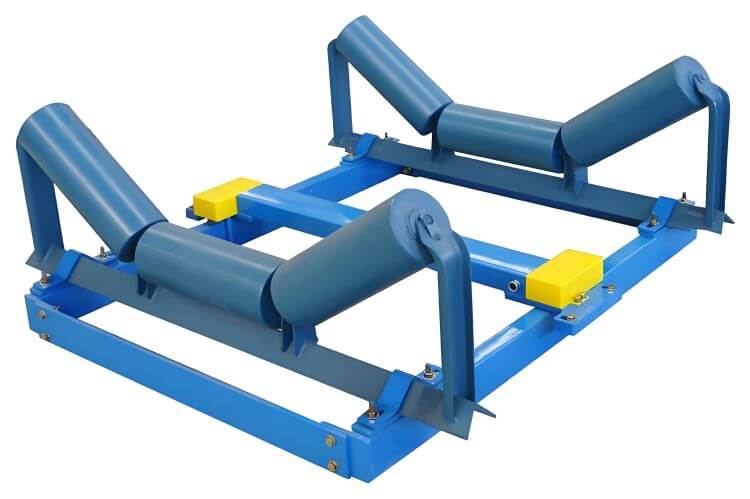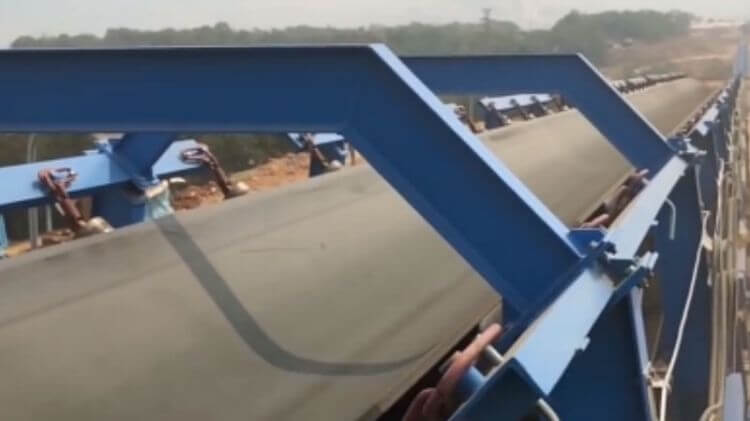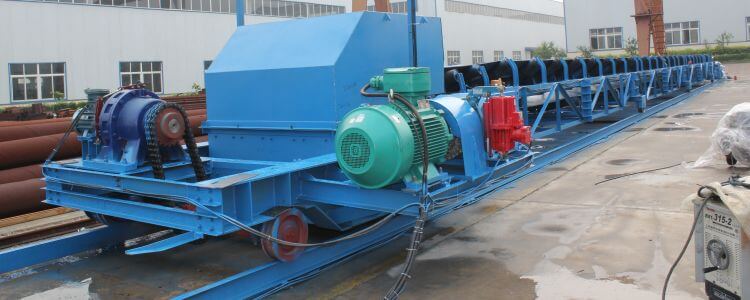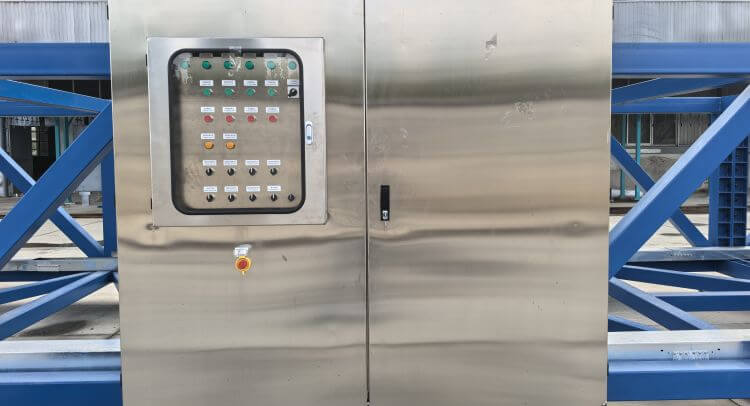Electronic belt scales, as core metering devices in bulk material handling systems, are widely used at the discharge ends of belt conveyors in mines, under discharge chutes of radial stackers, and at loading/unloading nodes of mobile shiploaders in ports and granaries. They perform dynamic weighing of bulk materials such as coal, ores, and grains. However, under complex operating conditions, their weighing accuracy is susceptible to multiple factors including equipment coordination challenges, environmental interference, and mechanical structural defects, leading to cumulative errors of 2%-5%. For example, at an iron ore terminal, when a truck unloader discharges materials at 800 tons/hour, belt tension fluctuations in the belt conveyor directly trigger instantaneous flow drift in the electronic belt scale, resulting in annual settlement losses exceeding $1 million.

Six Core Causes of Electronic Belt Scale Inaccuracies
1. Mechanical Structural Defects: Belt Tension Fluctuations and Support Instability
-
Cause Analysis:
- Lateral vibration of belts during high-speed operation (>4 m/s) of belt conveyors causes uneven force distribution in weighing sections (±200N fluctuations).
- Rigid support structures of weighing frames fail to adapt to dynamic loads, triggering instantaneous flow drift.
-
Optimization Strategies:
- Implement laser alignment technology for real-time belt position monitoring, synchronized with belt conveyor hydraulic tensioning systems (±10N precision).
- Upgrade weighing frames to "floating cross-torsion support structures," neutralizing 80% of mechanical vibration interference.
2. Environmental Interference: Dust, Humidity, and Thermal Deformation
-
Cause Analysis:
- Dust accumulation (PM10 >300 μg/m³) on sensors during outdoor operation of radial stackers reduces sensitivity by 40%.
- Thermal expansion/contraction of metal frames in mobile shiploaders under -30°C to 50°C temperature variations causes weighing frame deformation (max. 2.5mm offset).
-
Optimization Strategies:
- Equip weighing units with IP68-rated sealed enclosures filled with dry nitrogen to isolate dust and moisture (ideal for high-humidity port environments).
- Introduce multispectral thermal deformation compensation algorithms, using temperature-strain models for real-time corrections (<0.05mm error).
3. Electromagnetic Interference: Weak Signal Distortion
-
Cause Analysis:
- mV-level signals from load cells are vulnerable to electromagnetic interference from truck unloader variable-frequency drives and belt conveyor high-power motors.
- Improper cable routing induces common-mode noise (>50mV).
-
Optimization Strategies:
- Use double-shielded cables (single-end grounded shielding) with ≥30cm separation from power cables.
- Install isolation amplifiers (CMRR >120dB) at signal inputs to suppress high-frequency interference.
Please contact us using the info below if you have any questions about Causes and Countermeasures for Electronic Belt Scale Weighing Inaccuracies
- Zoomry official website
- +86 131-6401-6717
- oversea@zoomry.cn
4. Calibration Failures: Methodological and Periodic Defects
-
Cause Analysis:
- Traditional chain code calibration cannot simulate actual material distribution (density error ±15%).
- Overextended calibration intervals (>30 days) ignore parameter drift caused by equipment wear.
-
Optimization Strategies:
- Adopt "material separation + dynamic chain code" dual-mode calibration to enhance credibility.
- Deploy AI self-learning systems to predict calibration needs based on belt conveyor operational data (auto-alerts for threshold breaches).
5. Material Property Impacts: Adhesion and Off-Center Loading
-
Cause Analysis:
- High-moisture materials (e.g., clay) adhering to belts during transfers from truck unloaders to belt conveyors induce zero-point drift.
- Off-center material discharge from radial stackers causes belt loading imbalance (>20% unilateral load variance).
-
Optimization Strategies:
- Install pneumatic cleaners and ultrasonic material detectors for real-time residue removal.
- Optimize radial stacker boom angles and integrate automatic belt tracking rollers to correct discharge trajectories.
6. Maintenance Deficiencies: Inspection Gaps and Delayed Responses
-
Cause Analysis:
- Undetected issues like roller bearing wear and belt splice aging lead to sudden inaccuracies.
- Manual inspection-dependent fault resolution results in MTTR >8 hours.
-
Optimization Strategies:
- Deploy acoustic emission sensors and vibration analysis modules for 14-day advance warnings of critical component failures.
- Establish digital maintenance platforms for remote monitoring of mobile shiploaders, truck unloaders, and other equipment.

Precision Optimization Pathways and Engineering Practices
1. Dynamic Weighing Algorithm Enhancements
-
Technical Highlights:
- Integrate belt conveyor speed signals with load cell data via Kalman filtering to eliminate random noise.
- Apply FPGA hardware acceleration to reduce signal processing latency from 20ms to 2ms, improving instantaneous flow calculation accuracy.
-
Case Study:
A copper mine reduced monthly scale errors from 1.8% to 0.35% through algorithmic optimization, cutting annual settlement disputes by $2.2 million.
2. Equipment Synergy Control Strategies
-
Technical Highlights:
- Synchronize truck unloader and belt conveyor operations via PID-controlled discharge rates to stabilize belt loading within ±5%.
- Implement radial stacker posture feedback compensation, dynamically adjusting material parabolic trajectories based on boom elevation data.
-
Case Study:
A coal terminal extended calibration intervals from 7 to 60 days through equipment synergy optimization, boosting maintenance efficiency by 70%.
3. Standardized Maintenance System Development
-
Technical Highlights:
- Formulate the Belt Conveyor-Scale Coordination Protocol, defining thresholds for 20 critical parameters including tension and alignment.
- Develop calibration toolkits (laser speedometers, dynamic chain codes) for on-site rapid calibration.
-
Case Study:
A global grain trader deployed this system across 12 ports, achieving <0.5 annual scale failures per unit and 90% reduction in metering complaints.

Industry Trends and Long-Term Optimization Recommendations
1. Intelligentization Directions
- Edge Computing Terminals: Embed AI inference modules in mobile shiploader control cabinets for real-time anomaly detection (>95% accuracy).
- Digital Twin Models: Create virtual replicas of belt scales and belt conveyors for failure simulation and parameter pre-optimization.
2. Standardization Roadmap
- Promote adoption of ISO 21873 Continuous Totalizing Automatic Weighing Instruments (Belt Scales) to unify testing methods and error limits.
- Establish a global calibration lab network to provide metrological traceability for truck unloaders, radial stackers, and related equipment.

The inaccuracy of electronic belt scales fundamentally stems from the coupling effects of mechanical, electrical, material, and environmental factors. Through a three-dimensional technical matrix—dynamic algorithm optimization, equipment synergy control, and standardized maintenance—measurement accuracy can be stabilized within ±0.5%, meeting trade-level settlement requirements. This approach has been validated in complex scenarios involving belt conveyors and mobile shiploaders, offering reliable precision assurance for the global bulk material handling industry.

 ZOOMRY
ZOOMRY

